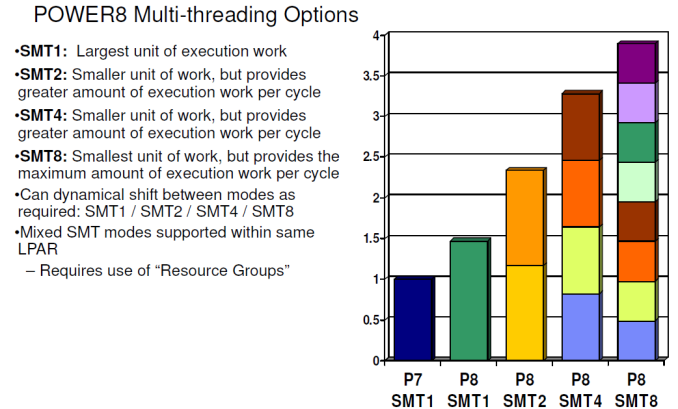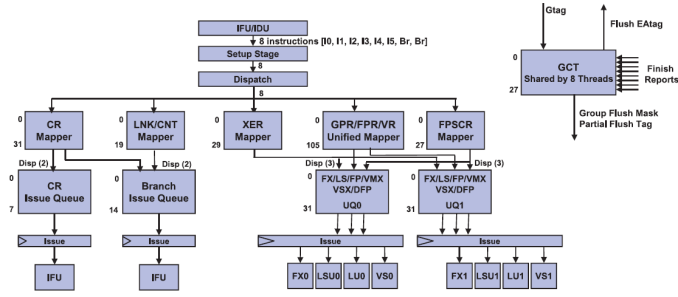Assessing IBM's POWER8, Part 1: A Low Level Look at Little Endian
by Johan De Gelas on July 21, 2016 8:45 AM ESTMulti Threading Prowess
The gains of 2-way SMT (Hyperthreading) on Intel processors are still relatively small (10-20%) in many applications. The reason is that threads have to share most of the critical resources such as L1-cache, the instruction TLB, µop cache, and instruction queue. That IBM uses 8-way SMT and still claims to get significant performance gains piqued our interest. Is this just benchmarketing at best or did they actually find a way to make 8-way SMT work?
It is interesting to note that with 2-way SMT, a single thread is still running at about 80% of its performance without SMT. IBM claims no less than a 60% performance increase due to 2-way SMT, far beyond what Intel has ever claimed (30%). This can not be simply explained by the higher amount of issue slots or decoding capabilities.
The real reason is a series of trade-offs and extra resource investments that IBM made. For example, the fetch buffer contains 64 instructions in ST mode, but twice as many entries are available in 2-way SMT mode, ensuring each thread still has a 64 instruction buffer. In SMT4 mode, the size of the fetch buffer for each thread is divided in 2 (32 instructions), and only in SMT8 mode things get a bit cramped as the buffer is divided by 4.
The design philosophy of making sure that 2 threads do not hinder each other can be found further down the pipeline. The Unified Issue Queue (UniQueue) consists of two symmetric halves (UQ0 and UQ1), each with 32 entries for instructions to be issued.
Each of these UQs can issue instructions to their own reserved Load/Store, Integer (FX), Load, and Vector units. A single thread can use both queues, but this setup is less flexible (and thus less performant) than a single issue queue. However, once you run 2 threads on top of a core (SMT-2), the back-end acts like it consists of two full-blown 5-way superscalar cores, each with their own set of physical registers. This means that one thread cannot strangle the other by using or blocking some of the resources. That is the reason why IBM can claim that two threads will perform so much better than one.
It is somewhat similar to the "shared front-end, dual-core back-end" that we have seen in Bulldozer, but with (much) more finesse. For example, the data cache is not divided. The large and fast 64 KB D-cache is available for all threads and has 4 read ports. So two threads will be able to perform two loads at the same time. Another example is that a single thread is not limited to one half, but can actually use both, something that was not possible with Bulldozer.
Dividing those ample resources in two again (SMT-4) should not pose a problem. All resources are there to run most server applications fast and one of the two threads will regularly pause when a cache miss or other stalls occur. The SMT-8 mode can sometimes be a step too far for some applications, as 4 threads are now dividing up the resources of each issue queue. There are more signs that SMT-8 is rather cramped: instruction prefetching is disabled in SMT-8 modus for bandwidth reasons. So we suspect that SMT-8 is only good for very low IPC, "throughput is everything" server applications. In most applications, SMT-8 might increase the latency of individual threads, while offering only a small increase in throughput performance. But the flexibility is enormous: the POWER8 can work with two heavy threads but can also transform itself into a lightweight thread machine gun.












124 Comments
View All Comments
nobodyblog - Thursday, July 21, 2016 - link
Please correct this error, you are saying you are comparing with BEST Intel can provide, but you did address Xeon for workloads need Xeon Phi Knight Landing which is a standalone CPU, too. If you choose correctly, the benchmark will be sooo different.IBM Power 8 is 90 GB/s, while Intel's Xeon phi knight landing (as 7290F) has a bandwidth of 400 GB/s.
IBM power 8 does above 600 gflops single precision and above 300 gflops double precision FLOPs, this is *10 in Xeon phi 7290F.
Specint: xeon phi is 1500 vs 1700 for power 8
Power and Price aside....
Thanks!
LukaP - Thursday, July 21, 2016 - link
If we start comparing different product categories, why not bring the GP100 into this as well. It will deliver 10TFLOPS of single precision and can be had for much less than any of these. But then again, there is the same caveat as the Xeon Phi. You cant actually run an OS on it, you need a host CPU and then you dispatch kernels onto the accelerator. Even if its a socketed version.smilingcrow - Thursday, July 21, 2016 - link
You can boot from newer Xeon Phi; either current or the next generation due maybe this year!LukaP - Thursday, July 21, 2016 - link
Oh really? :o that is neat, though not sure if that useful, since even highly parallel tasks usually have some IPC dependent components...Anyways have you got a source for that, would love to read more
Drumsticks - Thursday, July 21, 2016 - link
I'm a verification intern on the Phi team right now, and you can indeed boot Knight's Landing! Anandtech mentions it here: http://www.anandtech.com/show/9802/supercomputing-...nobodyblog - Friday, July 22, 2016 - link
Then you can add another xeon phi to above statistics... Xeon Phi KL is a CPU like other CPUs it does everything as mentioned even its specint is comparable, not so bad...Thanks!
tipoo - Friday, July 22, 2016 - link
Xeon Phi is x86, but it's GPU-like in nature, massively parallel for performance with low per-core performance. The IBM Power8 and other Xeons compete in highly parallel spaces like banking, but where single thread performance also still matters. Can't compare them.nobodyblog - Friday, July 22, 2016 - link
Xeon Phi Knight Landing has 3 times more single thread performance than silvermont (& knight corner).. I don't think it is so bad...The comparison is truly so, see the benchmarks, they say specint for example, or anything parallel performance, additionally, you can use a Xeon high performance with a xeon phi, there is nothing that prevents you. The benchmark is not about Database performance or parsing or anything similar, it is about this article, I don't say xeon phi is currently better positioned than xeon in these uses... But IBM's Power is not so, too, it has lots of core and lots of threads which is usable only in massive parallel uses...
Thanks!
nobodyblog - Friday, July 22, 2016 - link
On the IBM server, numactl was used to physically bind the 2, 4, or 8 copies of SPEC CPU to the first 2, 4, or 8 threads of the first core. On the Intel server, the 2 copy benchmark was bound to the first core. It is not single thread, it is a trick IBM uses to cheat in benchmarks, it is 425% percents slower than xeon in single thread.Thanks!
jospoortvliet - Tuesday, July 26, 2016 - link
The benchmarks here pit one core against one core. The IBM cores can run 1, 2, 4 or 8 threads on a single core, the Intel does 1 or 2. The 425%, not sure where that number comes from, but it isn't what shows out of these benchmarks.The benchmarks show, as described by Johan:
In single thread, the IBM does about 13% less work than the Intel core. In 2-thread mode, the IBM does about 20% more than the intel across the two threads. The intel doesn't do more than 2 threads, the IBM can and does then, on average, 43% more work across the eight threads than the Intel does with its two.
So Intel is single-thread master here, IBM is throughput king. Now if you have a HEAVILY threaded workload, with hundreds of threads and little latency requirements for each, Knights Landing or a GPU is a better choice, with their hundreds of cores. If latency is important and you can afford to use two to four threads per core the IBM performs best. If latency is everything, you keep it at 1 thread per core and the Intel Xeon is the best performer.
That is entirely ignoring cost, of course, both Intel and IBM have high and low cost solutions with their downsides and benefits. This set of benchmarks simply pitted one core against another, entirely ignoring the differences in core count (IBM 10, Intel 22) and price (Intel orders of magnitude more expensive). You'll always have to look at a bigger picture: how many cores do you get for your dollar and what are your requirements.
Performance/watt, the Intel probably wins in all area's, at least if the system is idle frequently. Without idle the IBM might be not that bad, perf/power wise.
The big take-away from this article is, though, that IBM has built a system which can be quite price-competitive with Intel in the lower-high end market. To really be able to make a choice, we'd probably need a benchmark of two price-equivalent systems. I bet the workload would make a huge difference in who wins the price/performance fight.